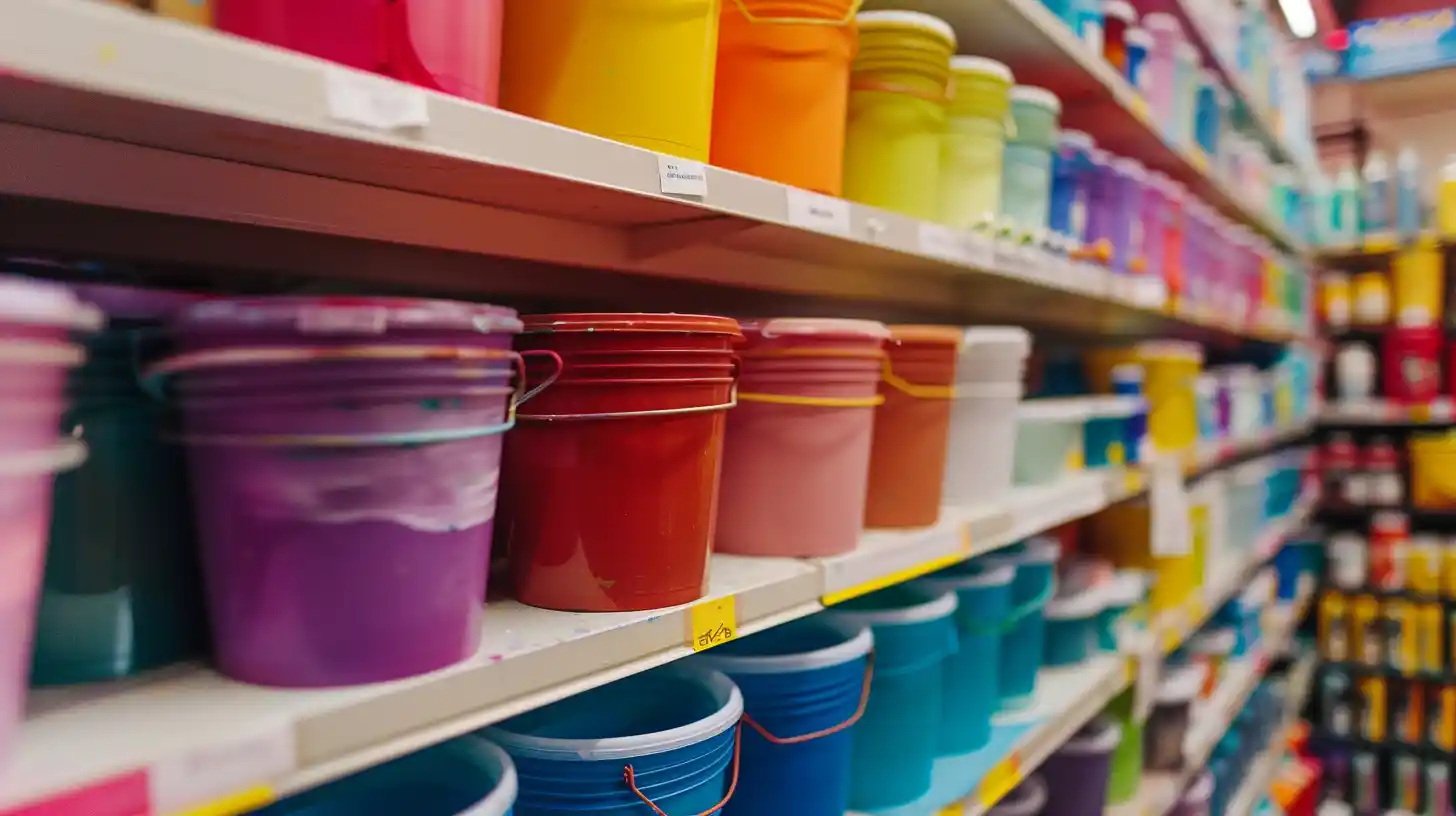Table of Contents
Quality Service Guarantee Or Painting Free

Get a rental agreement with doorstep delivery

Find the BEST deals and get unbelievable DISCOUNTS directly from builders!

5-Star rated painters, premium paints and services at the BEST PRICES!
Loved what you read? Share it with others!


Submit the Form to Unlock the Best Deals Today
Help us assist you better
Check Your Eligibility Instantly

Experience The NoBrokerHood Difference!
Set up a demo for the entire community
VOC Paint: Navigating Through Benefits, Risks & Solutions
Table of Contents
Tired of compromising indoor air quality while striving for a stunning paint finish? Volatile Organic Compounds (VOCs) are chemicals found in many traditional paints that can have both short-term and long-term effects on your health. In this blog, we'll delve into the world of VOC paints, exploring their benefits, risks, and eco-friendly solutions for a safer and more sustainable home.
What is VOC Paint?
Volatile Organic Compounds (VOCs) are chemicals emitted as gases from certain solids and liquids, including paints. VOC paint contains these compounds, which can have adverse effects on indoor air quality and human health. When VOC paint is applied, these compounds can evaporate into the air and contribute to indoor air pollution. Understanding the nature of VOC paint is crucial for making informed choices about the products we use in our homes and workspaces.
In the context of paints, VOC paint means the paint has solvents that enhance paint performance but can have adverse effects on human health and the environment.
Quality Service Guarantee Or Painting Free

Get a rental agreement with doorstep delivery

Find the BEST deals and get unbelievable DISCOUNTS directly from builders!

5-Star rated painters, premium paints and services at the BEST PRICES!
Which VOCs are Found in Paint?

Common VOCs found in paint include formaldehyde, benzene, toluene, and xylene, among others. These compounds can lead to various health issues such as eye and respiratory irritation, and headaches, and even contribute to long-term health problems. Being aware of the specific VOCs present in paint allows us to gauge the potential risks associated with their use and make decisions accordingly.
Levels of VOC in Paint

What Constitutes a Safe VOC Level in Paint?
A safe level of VOC in paint is typically considered to be around 50 grams per litre or lower as per VOC paint regulations. Paints labelled as “low VOC” or “zero VOC” paint in India generally adhere to these standards, releasing fewer harmful chemicals into the air during and after application. Opting for paints with lower VOC content or the best VOC-free paint can significantly contribute to maintaining a healthier indoor environment.
What Constitutes a High VOC Level in Paint?
A high level of VOC in paint, often exceeding 150 grams per litre, can lead to elevated indoor VOC concentrations. This can result in a range of health issues, especially for those with respiratory sensitivities or compromised immune systems. High VOC content also contributes to that distinctive "paint smell" that can linger for days or even weeks after application.
| Aspect | VOC Paints | Low VOC Paints | No VOC Paints |
| VOC Content | High levels of VOCs | Reduced VOC content | Virtually no VOCs |
| Health Impact | Can cause short and long-term health issues, including respiratory problems | Lower health risks compared to high-VOC paints | Minimal to no health risks associated with VOC exposure |
| Environmental Impact | Contributes to outdoor air pollution and can harm ecosystems | Reduces environmental impact, with fewer pollutants released | Minimal environmental impact, as they release little to no harmful chemicals |
| Performance | Often offers better coverage and durability | Good performance, with improvements in drying time and finish | Comparable or even superior performance in terms of coverage and durability |
| Odor | Strong and lingering odor during and after application | Mild to moderate odor, dissipating more quickly | Virtually odorless |
| Drying Time | Quick drying time due to the presence of VOC solvents | Slightly longer drying time compared to high-VOC paints | Drying time may vary but generally comparable to VOC paints |
| Availability and Cost | Widely available, often more affordable | Increasing availability with competitive pricing | May be slightly more expensive, but costs are decreasing with growing demand |
| Certifications | May lack eco-friendly certifications | Often certified as eco-friendly, meeting specific standards | Typically certified by third-party organizations for being VOC-free or low-VOC |
How Long Do VOCs Last in Paint?
VOC emissions from freshly painted surfaces can last for weeks or even months, gradually decreasing over time. Proper ventilation, air purifiers, and choosing low VOC exterior paints can help expedite the dissipation of these emissions, allowing you to enjoy a cleaner and healthier living space.
How Can I Reduce VOC Levels in My Home?
To reduce latex paint VOC exposure, ensure proper ventilation, use air purifiers, and choose low-VOC paints and building materials. Regularly cleaning and maintaining your indoor environment can also help in reducing VOC levels over time. Additionally, incorporating indoor plants known for air-purifying properties can contribute to improved air quality.
What is the Safest Paint to Use?
Several reputable paint brands offer low and zero-VOC paint options. Some popular choices include Benjamin Moore Natura, Sherwin-Williams Harmony, and Behr Premium Plus Ultra. These paints are designed to minimize VOC emissions without compromising on colour variety or coverage quality.
Uses of VOC paint
Discover the diverse applications of VOC paint in interior and exterior settings, from enhancing aesthetics to protecting surfaces with lasting beauty.
VOC paints find applications in a wide range of projects, from refreshing interior walls to revitalising outdoor surfaces. Whether you're looking to add a splash of colour to your living room or protect your home's exterior from the elements, there's a VOC paint suitable for your needs.
Prices of VOC paint
The prices of VOC paint can vary based on factors such as brand, quality, and the specific type of paint you choose. While low-VOC and zero-VOC paints might be slightly more expensive than traditional options, the benefits they offer in terms of better indoor air quality and reduced health risks are well worth the investment.
Here are some examples of the prices of different VOC paints in the market:
- Low VOC paint: This type of paint typically has a VOC content of less than 100 grams per litre. Prices for low VOC paint range from Rs. 200 to Rs. 500 per litre.
- Zero VOC paint: This type of paint has no VOCs. Prices for zero VOC paint range from Rs. 400 to Rs. 800 per litre.
- Natural paint: This type of paint is made from natural ingredients, such as plant oils and minerals. Prices for natural paint range from Rs. 500 to Rs. 1000 per litre.
It is important to note that these are just estimates and the actual prices may vary depending on the retailer and the specific product. Prior to making a purchase, it's recommended to compare prices for the best choice.
Factors to consider when choosing a VOC paint
When choosing a VOC paint, it is important to consider the following factors:
- The VOC content: The lower the VOC content, the better for your health and the environment.
- The type of paint: There are different types of VOC paints available, each with its own advantages and disadvantages. For example, low-VOC paints are typically more expensive than traditional paints, but they offer better health benefits.
- The quality of the paint: The quality of the paint will affect its durability and performance.
- The price: The price of the paint will vary depending on the brand, type, and quality.
It is also important to read the label carefully before purchasing a VOC paint. The label should include information about the VOC content, the type of paint, and the application instructions.
How Can NoBroker Help?
In conclusion, VOC paint awareness is your stepping stone to a healthier, safer living environment. Remember, selecting low or zero-VOC paints not only enhances aesthetics but also safeguards indoor air quality. Take the next step by applying these insights to your painting projects and contribute to a better atmosphere for your loved ones.
However, embarking on this journey alone might bring uncertainties. Struggling with choices and potential health concerns can be daunting. This is where NoBroker comes to your aid, ensuring a seamless path toward the right paint solutions.
At NoBroker, we specialize in guiding you through these challenges. With a reputation for expertise and customer satisfaction, we're here to ensure a smooth, hassle-free experience. Contact NoBroker today for swift and effective solutions, securing a healthier and more beautiful living space for you and your family.
Frequently Asked Questions
A. VOC paint stands for Volatile Organic Compound paint, which contains chemicals that can evaporate into the air and affect indoor air quality. Understanding VOC paint is crucial for making informed choices about the paints we use in our homes and workplaces to ensure a healthier living environment.
A. Absolutely! Organic paints offer a safer alternative, especially in households with curious kids. These paints are made from natural ingredients and contain no harmful chemicals, ensuring that even if your children touch the walls, there's minimal risk to their health.
A. Yes, organic paints do tend to be slightly pricier than conventional paints. However, the added cost is a worthwhile investment in your family's well-being. By using organic paints, you're creating a healthier environment for your loved ones to live in.
A. Organic paints are designed to be just as durable and long-lasting as traditional paints. While they might need a bit of extra care during application and maintenance, the effort is minimal compared to the peace of mind you'll gain from knowing your loved ones are safe from harmful chemicals.
A. Chemicals are commonly added to paint to achieve specific properties and enhance performance. These chemicals contribute to factors like colour, durability, drying time, and consistency. They also help prevent microbial growth, improve adhesion, and ensure the paint's longevity.
A. While VOCs (Volatile Organic Compounds) are the most well-known contributors to indoor air pollution, other chemicals in paint can also have varying degrees of impact on human health. Some chemicals, like formaldehyde and heavy metals, can be harmful even in low concentrations.
Painting Service in Top Cities in India
Recommended Reading

25+ Creative Flower Wall Painting Design Ideas for a Stylish Home in 2025
December 8, 2024
1597+ views

Best Washable Wall Paint for Long-Lasting Durability and Easy Cleaning in 2024
October 10, 2024
3543+ views

The Ultimate Guide to Limewash Paint for Your Space
September 24, 2024
2623+ views

Sea Green Wall Paint Design Ideas: Redefining Your Space
March 20, 2024
2352+ views

Stunning Marble Wall Paint Ideas to Elevate Your Space
March 12, 2024
1919+ views
Loved what you read? Share it with others!
NoBroker Painting Testimonials
Before this festive season
get your house painted
Most Viewed Articles

40+ Best Stunning Two Colour Combinations for Bedroom Walls to Elevate Your Space in 2024
October 19, 2024
301289+ views

Best Exterior House Colour Combinations: 16 Ways to Make Your Home More Attractive
December 17, 2024
116151+ views

Asian Paint Price 20 Litre: Complete Guide to Different Variants and Costs in 2025
December 17, 2024
48143+ views

Top 18 Main Gate Colour Combinations for Indian Homes
December 17, 2024
35770+ views

Top Asian Paints Colour Codes: Transform Your Home with Latest Colours 2025
December 17, 2024
31610+ views
Painting Services in Top Cities of India
Top Paint Brands in India
| Asian Paints | Nerolac Paints |
| Berger Paints | Indigo Paints |
| Dulux Paints | Nippon Paints |
| Shalimar Paints |
Recent blogs in
Asian Paint Colour Price in India 2025
December 20, 2024 by NoBroker.com
20 Best Baby Pink Colour Combinations: Stylish Pairings for a Charming Home 2025
December 20, 2024 by NoBroker.com
12 Wall Colour Combination with White that will Transform Your Home 2025
December 19, 2024 by Ananth




Join the conversation!